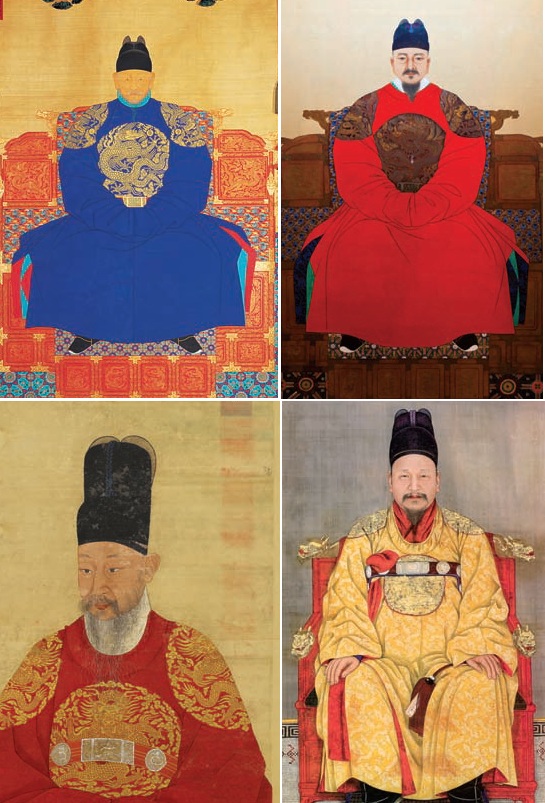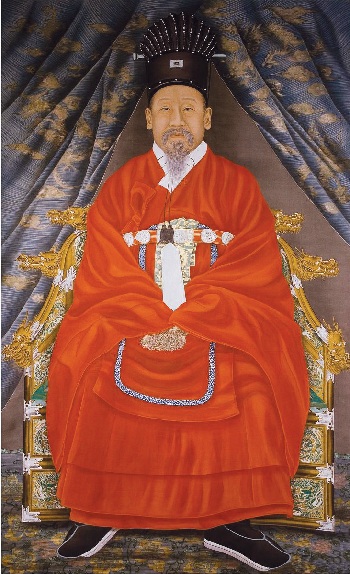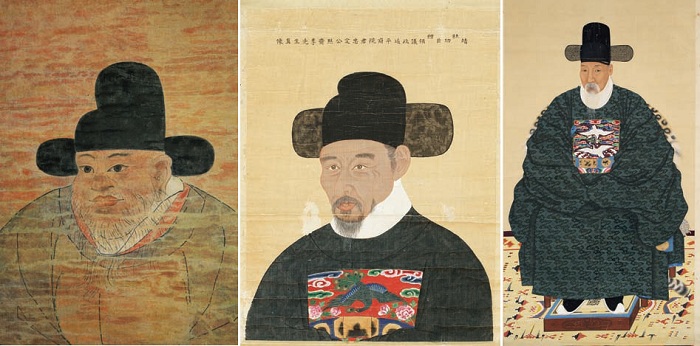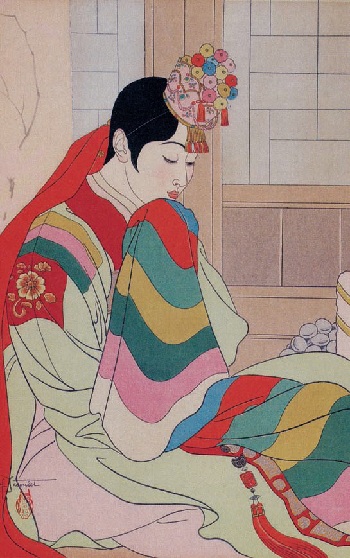View this article in another language
- 한국어
- English
- 日本語
- 中文
- العربية
- Español
- Français
- Deutsch
- Pусский
- Tiếng Việt
- Indonesian
*This is the twelfth part in our series, “Gat, traditional headgear in Korea.”

The king's everyday uniform and the ikseongwan
Picture No. 1 is a portrait of King Taejo (r. 1392-1398), the first king of the Joseon Dynasty (1392-1910). Born as Yi Seong-gye, the picture shows him in his royal, everyday attire. He is wearing a blue royal robe, the gollyongpo, and a black ikseongwan. The five-clawed dragon design, drawn on the shoulders, chest and back of the robe with gold gilt paint, is so large that it almost covers the whole robe.
Picture No. 2 is a portrait of King Sejong The Great (r. 1418-1450) wearing his red royal robes. This garment also has large dragon-themed patches on the chest and shoulders. His robe is somewhat looser around the collar than King Taejo's.
Picture No. 3 shows the bust of King Yeongjo (r. 1724-1776) in the red royal robes. Compared to the previous two pictures, you can see that by the 1700s the crown part of the hat is taller and its wings are larger. The collar on the robe is looser, as well.
Picture No. 4 features Emperor Gojong wearing the yellow dragon robes he donned after he declared himself an emperor. His crown is smaller than that of King Yeongjo, and the size of the patches on the robe are also smaller. The five-clawed dragon motif here is embroidered with gold thread. The dragon in the patches sewn onto the chest and the right shoulder is carrying a red cintamani in its mouth, a Buddhist jewel that makes your wishes come true, which symbolizes the sun. The dragon in the patches on the back and the left shoulder is holding a white cintamani in its mouth, symbolizing the moon. This yellow dragon robe has wide sleeves called duri sleeves.
The ikseongwan is the official crown for the kings and crowns prince of Joseon. It was worn with their everyday gollyongpo attire, corresponding to the official hat and uniform, the samogwandae, worn by court officials. The hat was also coupled with the crown prince and his eldest son's study clothes. It is shaped as a two-tiered crown, the back part higher than the front, with two flaps sticking out from the back, which represent the wings of a cicada. The blue threads sewn onto the front were used to tie the two wings together. The crown was usually made with purple silk gauze, but black fabric was used to make one to be worn with clothing for the mourning period. The wings on the silk hat worn by court officials as part of their official attire point toward the earth while the wings on the royal crown point skyward, distinguishing the king and his retainers. Unlike the golden crown and ceremonial coronet, the system concerning the ikseongwan did not change until the very end of the Joseon Dynasty, so the hat was still used as it was even after the accession of Gojong as emperor.

Emperor Gojong wearing the tongcheongwan
Kings wore the royal wonyugwan crown and the ceremonial red gangsapo robes when performing small ancestral rites on the first day of the month or else on the first full-moon day by the lunar calendar. They also received gifts from their subjects and conducted brief royal ceremonies, such as birthday ceremonies and visits to the queen dowager following auspicious ceremonies. After the proclamation of the Korean Empire in 1897, monarchs wore the tongcheongwan, the emperor's crown, instead of the king's crown. Differences between the two are the number of vertical lines on the crown, the number of cicada-shaped ornaments, the material of the ornamental hairpin and whether or not the sansul decoration adorned the forehead. Whereas the king's crown had nine cicadas on nine lines with a gold hairpin and no sansul decoration. The emperor's crown, as seen in the portrait of Gojong, above, has 12 cicadas on 12 lines with a jade hairpin and a sansul on the forehead.
The gangsapo, like the royal robes in the portrait, consist of a pair of red pants, an inner robe and other accessories, including a decorative panel, a jade waist chain, a large belt, shoes, socks and a jade stick. It is the same with the royal robes in shape and components, but has different colors and no royal coat of arms, characteristic of the royal robes.
Samo, the symbol of court officials
The dallyeong was the official's robe and was always paired with the samo official hat and the gakdae belt. The shape of the official's hat underwent dramatic changes over time, as did the horsehair hat. The differences in the height of the crown part of the hat and the size and shape of the wing-shaped decorations show the trends of the times. Officials were required to wear them all the time, except on rainy or snowy days, so that they could retain their courtly dignity. Ju Se-bung (1495-1554), seen in the picture, is wearing a hat with a relatively low crown and small wings on both sides. Yi Gui (1567-1633), in picture No. 2, is wearing a hat with a low rear crown and wider wings. Chae Je-gong (1720-1799), in picture No. 3, is wearing a hat with a high crown and long narrow wings, compared to the former two pictures.
Court officials during the Joseon Dynasty usually wore the official's hat with their everyday attire, but commoners were only allowed to wear them at wedding ceremonies. The official's hat is composed of a low front crown and a tall rear crown, with two wings at the back. The name samo means "silk hat." It refers to the silk cover enveloping the exterior made of bamboo strips and horsehair.

The shape of the hat changed over time. In the early years of the Joseon Dynasty, hats were decorated with strings hung from both sides or with soft wings. The latter were replaced with hard wings around the time of King Myeongjong (r. 1545-1567) and from the middle years of the Joseon Dynasty, the wings became wider and horizontal, while the crown became much taller. In the later years, the wings grew shorter and curved forward with the width unchanged. The crown, too, was again lowered.
The very first record of the official's hat can be found in the Goryeosa, the History of the Goryeo Dynasty. It states that an official's hat and robes were bestowed upon Seol Jang-su by Emperor Taizu of the Ming Dynasty in May 1387, the 13th year of King Wu of the Goryeo Dynasty. Upon his return to Korea, officials of all ranks followed this mode of dress.
In December 1417, the 17th year of his reign, King Taejong (r. 1400-1418) of the Joseon Dynasty accepted the suggestion of his retainers and ordered that every official wear the official's hat instead of the horsehair hat at court.
In February 1426, the 8th year of King Sejong's (r. 1418-1450) rule, the hat was included as part of an official's everyday uniform. It became the most widely used hat for officials until the end of the Joseon Dynasty in the early years of the 20th century. Replacing other official hats, it was worn with various kinds of official attire. Even after the dress code reform of King Gojong (r. 1863-1907), officials still wore the hat both with ceremonial attire or with their everyday uniform.

A docile bride wearing hwagwan
A fancy coronet with floral decorations, called a hwagwan, beautifully matches the bride who is seated in a modest manner, her eyes cast downward. It is a kind of headdress worn by women with their ceremonial costume and also has significant aesthetic value. First introduced with Chinese costumes during the reign of King Munmu (r. 661-681) of the Silla Dynasty, it was coupled with the court dress during the Unified Silla period (668-935) and with upper class women's ceremonial costumed during the Goryeo Dynasty (918-1392).
Its size became smaller during the Joseon Dynasty (1392-1910). The bans on hairpieces issued by King Yeongjo (r. 1724-1776) and King Jeongjo (r. 1776-1800) recommended the use of ceremonial coronets, such as the jokduri, a ceremonial coronet, or the hwagwan, a ceremonial hairstyle using fake hairpieces, and both the courtly class and commoners began to wear the coronet.
Yebok, a book of ceremonial costumes, also recommends wearing the two types of coronets with women's formal or semi-formal wear. Only gisaeng, a type of courtesan, female shamans and dancers wore them during court feasts in the earlier days of the Joseon Dynasty, but the hairstyle reforms allowed the upper class to wear coronets instead of hairpieces, as well as commoners to wear them at weddings.
Making a hwagwan first requires a crown-shaped paper or fabric frame, on which floral paper decorations and paper strings are added. Then, a flower-shaped jade board is decorated with orpiment, amber, jade and pearls. It is finally secured on the top of the head using two small hairpins. During the later Joseon years, women would wear their jokduri with their formal attire and their hwagwan with their elaborate ceremonial robes or jackets.
*This series of article has been made possible through the cooperation of the National Research Institute of Cultural Heritage. (Source: Intangible Cultural Heritage of Korea)

(Top, left) 1. King Taejo (r. 1392-1398); (Top, right) 2. King Sejong The Great (r. 1418-1450); (Bottom, left) 3. King Yeongjo (r. 1724-1776); (Bottom, right) 4. Emperor Gojong (r. 1863-1907)
The king's everyday uniform and the ikseongwan
Picture No. 1 is a portrait of King Taejo (r. 1392-1398), the first king of the Joseon Dynasty (1392-1910). Born as Yi Seong-gye, the picture shows him in his royal, everyday attire. He is wearing a blue royal robe, the gollyongpo, and a black ikseongwan. The five-clawed dragon design, drawn on the shoulders, chest and back of the robe with gold gilt paint, is so large that it almost covers the whole robe.
Picture No. 2 is a portrait of King Sejong The Great (r. 1418-1450) wearing his red royal robes. This garment also has large dragon-themed patches on the chest and shoulders. His robe is somewhat looser around the collar than King Taejo's.
Picture No. 3 shows the bust of King Yeongjo (r. 1724-1776) in the red royal robes. Compared to the previous two pictures, you can see that by the 1700s the crown part of the hat is taller and its wings are larger. The collar on the robe is looser, as well.
Picture No. 4 features Emperor Gojong wearing the yellow dragon robes he donned after he declared himself an emperor. His crown is smaller than that of King Yeongjo, and the size of the patches on the robe are also smaller. The five-clawed dragon motif here is embroidered with gold thread. The dragon in the patches sewn onto the chest and the right shoulder is carrying a red cintamani in its mouth, a Buddhist jewel that makes your wishes come true, which symbolizes the sun. The dragon in the patches on the back and the left shoulder is holding a white cintamani in its mouth, symbolizing the moon. This yellow dragon robe has wide sleeves called duri sleeves.
The ikseongwan is the official crown for the kings and crowns prince of Joseon. It was worn with their everyday gollyongpo attire, corresponding to the official hat and uniform, the samogwandae, worn by court officials. The hat was also coupled with the crown prince and his eldest son's study clothes. It is shaped as a two-tiered crown, the back part higher than the front, with two flaps sticking out from the back, which represent the wings of a cicada. The blue threads sewn onto the front were used to tie the two wings together. The crown was usually made with purple silk gauze, but black fabric was used to make one to be worn with clothing for the mourning period. The wings on the silk hat worn by court officials as part of their official attire point toward the earth while the wings on the royal crown point skyward, distinguishing the king and his retainers. Unlike the golden crown and ceremonial coronet, the system concerning the ikseongwan did not change until the very end of the Joseon Dynasty, so the hat was still used as it was even after the accession of Gojong as emperor.

Emperor Gojong (r. 1863-1907)
Emperor Gojong wearing the tongcheongwan
Kings wore the royal wonyugwan crown and the ceremonial red gangsapo robes when performing small ancestral rites on the first day of the month or else on the first full-moon day by the lunar calendar. They also received gifts from their subjects and conducted brief royal ceremonies, such as birthday ceremonies and visits to the queen dowager following auspicious ceremonies. After the proclamation of the Korean Empire in 1897, monarchs wore the tongcheongwan, the emperor's crown, instead of the king's crown. Differences between the two are the number of vertical lines on the crown, the number of cicada-shaped ornaments, the material of the ornamental hairpin and whether or not the sansul decoration adorned the forehead. Whereas the king's crown had nine cicadas on nine lines with a gold hairpin and no sansul decoration. The emperor's crown, as seen in the portrait of Gojong, above, has 12 cicadas on 12 lines with a jade hairpin and a sansul on the forehead.
The gangsapo, like the royal robes in the portrait, consist of a pair of red pants, an inner robe and other accessories, including a decorative panel, a jade waist chain, a large belt, shoes, socks and a jade stick. It is the same with the royal robes in shape and components, but has different colors and no royal coat of arms, characteristic of the royal robes.
Samo, the symbol of court officials
The dallyeong was the official's robe and was always paired with the samo official hat and the gakdae belt. The shape of the official's hat underwent dramatic changes over time, as did the horsehair hat. The differences in the height of the crown part of the hat and the size and shape of the wing-shaped decorations show the trends of the times. Officials were required to wear them all the time, except on rainy or snowy days, so that they could retain their courtly dignity. Ju Se-bung (1495-1554), seen in the picture, is wearing a hat with a relatively low crown and small wings on both sides. Yi Gui (1567-1633), in picture No. 2, is wearing a hat with a low rear crown and wider wings. Chae Je-gong (1720-1799), in picture No. 3, is wearing a hat with a high crown and long narrow wings, compared to the former two pictures.
Court officials during the Joseon Dynasty usually wore the official's hat with their everyday attire, but commoners were only allowed to wear them at wedding ceremonies. The official's hat is composed of a low front crown and a tall rear crown, with two wings at the back. The name samo means "silk hat." It refers to the silk cover enveloping the exterior made of bamboo strips and horsehair.

(From left) Ju Se-bung (1495-1554); Yi Gui (1557-1633); Chae Je-gong (1720-1799)
The shape of the hat changed over time. In the early years of the Joseon Dynasty, hats were decorated with strings hung from both sides or with soft wings. The latter were replaced with hard wings around the time of King Myeongjong (r. 1545-1567) and from the middle years of the Joseon Dynasty, the wings became wider and horizontal, while the crown became much taller. In the later years, the wings grew shorter and curved forward with the width unchanged. The crown, too, was again lowered.
The very first record of the official's hat can be found in the Goryeosa, the History of the Goryeo Dynasty. It states that an official's hat and robes were bestowed upon Seol Jang-su by Emperor Taizu of the Ming Dynasty in May 1387, the 13th year of King Wu of the Goryeo Dynasty. Upon his return to Korea, officials of all ranks followed this mode of dress.
In December 1417, the 17th year of his reign, King Taejong (r. 1400-1418) of the Joseon Dynasty accepted the suggestion of his retainers and ordered that every official wear the official's hat instead of the horsehair hat at court.
In February 1426, the 8th year of King Sejong's (r. 1418-1450) rule, the hat was included as part of an official's everyday uniform. It became the most widely used hat for officials until the end of the Joseon Dynasty in the early years of the 20th century. Replacing other official hats, it was worn with various kinds of official attire. Even after the dress code reform of King Gojong (r. 1863-1907), officials still wore the hat both with ceremonial attire or with their everyday uniform.

The Bride, 1948, Paul Jacoulet
A docile bride wearing hwagwan
A fancy coronet with floral decorations, called a hwagwan, beautifully matches the bride who is seated in a modest manner, her eyes cast downward. It is a kind of headdress worn by women with their ceremonial costume and also has significant aesthetic value. First introduced with Chinese costumes during the reign of King Munmu (r. 661-681) of the Silla Dynasty, it was coupled with the court dress during the Unified Silla period (668-935) and with upper class women's ceremonial costumed during the Goryeo Dynasty (918-1392).
Its size became smaller during the Joseon Dynasty (1392-1910). The bans on hairpieces issued by King Yeongjo (r. 1724-1776) and King Jeongjo (r. 1776-1800) recommended the use of ceremonial coronets, such as the jokduri, a ceremonial coronet, or the hwagwan, a ceremonial hairstyle using fake hairpieces, and both the courtly class and commoners began to wear the coronet.
Yebok, a book of ceremonial costumes, also recommends wearing the two types of coronets with women's formal or semi-formal wear. Only gisaeng, a type of courtesan, female shamans and dancers wore them during court feasts in the earlier days of the Joseon Dynasty, but the hairstyle reforms allowed the upper class to wear coronets instead of hairpieces, as well as commoners to wear them at weddings.
Making a hwagwan first requires a crown-shaped paper or fabric frame, on which floral paper decorations and paper strings are added. Then, a flower-shaped jade board is decorated with orpiment, amber, jade and pearls. It is finally secured on the top of the head using two small hairpins. During the later Joseon years, women would wear their jokduri with their formal attire and their hwagwan with their elaborate ceremonial robes or jackets.
*This series of article has been made possible through the cooperation of the National Research Institute of Cultural Heritage. (Source: Intangible Cultural Heritage of Korea)
![Gat, traditional headgear in Korea [11]](/upload/content/image/1397540120606.jpg)
![Gat, traditional headgear in Korea [10]](/upload/content/image/1396945520376.jpg)
![Gat, traditional headgear in Korea [9]](/upload/content/image/1396331775823.jpg)
![Gat, traditional headgear in Korea [8]](/upload/content/image/1395720334038.jpg)
![Gat, traditional headgear in Korea [7]](/upload/content/image/1395108155289.jpg)
![Gat, traditional headgear in Korea [6]](/upload/content/image/1393924045608.jpg)
![Gat, traditional headgear in Korea [5]](/upload/content/image/1393319340768.jpg)
![Gat, traditional headgear in Korea [4]](/upload/content/image/1392690825210.jpg)
![Gat, traditional headgear in Korea [3]](/upload/content/image/1392095636707.jpg)
![Gat, traditional headgear in Korea [2]](/upload/content/image/1391590339998.jpg)
